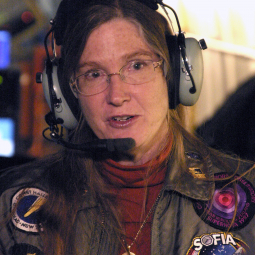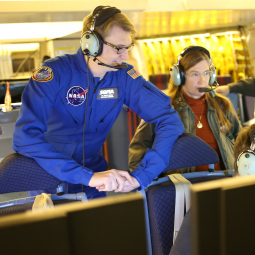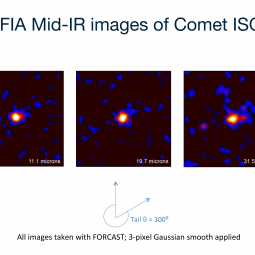NASA’s Stratospheric Observatory for Infrared Astronomy (SOFIA) took off on a “target of opportunity” flight that included study of Comet ISON on Oct. 24, 2013. This was SOFIA's second opportunity to capture data on a comet, having previously studied Comet Hartley 2 in 2010. For the Comet ISON observations, the object was predicted to be very faint.
The observatory’s flight path saw NASA’s highly modified 747SP airplane depart its home base at Palmdale, Calif., around 9:30 p.m. local time, fly east to Colorado, then turn northeast passing over the Canadian township of Pickle Lake, Ontario, then heading west over Medicine Hat, Alberta, where the observatory turned south and continued flying toward the United States. The comet observations began south of the Canadian border, above the border of Idaho and Montana at 43,000 feet. The entire non-stop flight took nearly 10 hours to complete.
Comet ISON, a pristine chunk of primordial material from the Oort Cloud, recently entered the inner solar system for the very first time and is heading toward a close encounter with the sun. On Nov. 28, 2013, Thanksgiving Day, Comet ISON will reach perihelion, passing within 730,000 miles of the Sun. The comet was discovered in September 2012, by researchers Vitali Nevski and Artyom Novichonk using the International Scientific Optical Network’s (ISON) 0.4-meter (16-inch) telescope, and was named in honor of the institution.
Aboard the Oct. 24 SOFIA flight was principal investigator Diane Wooden, who had proposed that Comet ISON be studied at three infrared wavelengths. Two of those wavelengths, 19.7 and 31.5 microns, cannot be seen from Earth-based telescopes because water vapor in Earth’s atmosphere blocks infrared energy from reaching the ground. It should be noted that the 31.5 micron wavelength was detected simultaneously with the 11.1 and 19.7 micron images. The second wavelength examined during the flight, 11.1 microns, allows the SOFIA observations to be tied to ground-based measurements with the Subaru Telescope located on Mauna Kea, Hawaii, and the Great Canary Telescope on the island of La Palma, in Spain’s Canary Islands. Currently, there are no space-borne telescopes operating at wavelengths longer than 4.5 microns, thus SOFIA is the only telescope able to see these limited wavelengths.
Wooden is working with a diverse team that will combine its numerous observations to better understand the composition of Comet ISON. Her observations aboard SOFIA were to measure the thermal emission from small and large dust grains in the coma of Comet ISON by measuring the mid-infrared wavelengths with the Faint Object InfraRed CAmera for the SOFIA Telescope (FORCAST) instrument. FORCAST collects infrared photons at wavelengths between five- and 40-microns.
“The long wavelength photometry, only possible from SOFIA, will allow us to measure the thermal emission from larger grains, which cannot be seen in scattered light at visible wavelengths,” said Wooden. “Compared with smaller submicron grains, larger grains have cooler temperatures and emit at longer wavelengths. Only the FORCAST instrument on SOFIA can obtain the longer wavelength photometry measurements that sample the thermal emission of the larger grains. By modeling the FORCAST photometry, we can constrain the grain size distribution and the dust mass. The dust mass and the dust mass loss rate are one of the fundamental characterizations of a comet.”
Making the Observations
“We got onto the comet leg of the flight and clearly saw the extended coma in the fine guiding camera but not in the wide-angle camera,” Wooden said. “We acquired images at 11.1 microns and immediately saw the comet was faint. We then shifted to the 19.7-micron filter, where the comet was expected to be brighter. Soon we could see the comet was about as weak at 19.7 microns as it was 11.1 microns, consistent with the expectations of a typical grain-size distribution. If the 19.7-micron images had a stronger signal, that would have meant there were more, larger grains.
“These measurements are important because they serve as constraints or upper limits on the flux of thermal emissions from larger dust grains in the coma,” said Wooden. “Studying the dust’s thermal emission from SOFIA enables us to derive the grain size, its distribution, and the mass of the amount of dust coming from the comet. This is a critical complement to studying the gases that are released, and thereby contributes significantly to understanding the origins of comets.
“We learned that the comet is dust-poor not only for small grains, as already known by the weak scattered light at visible wavelengths, but also for larger grains detectable at these mid-IR wavelengths from SOFIA.”
Nicholas A. Veronico
SOFIA Public Affairs


